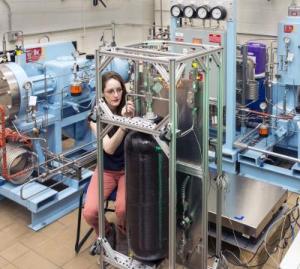Jul 24 2014
To support the fair sale of gaseous hydrogen as a vehicle fuel, researchers at the National Institute of Standards and Technology (NIST) have developed a prototype field test standard to test the accuracy of hydrogen fuel dispensers.
 NIST's Jodie Pope and her team have developed this prototype field test standard to test the accuracy of hydrogen fuel dispensers. Credit: Suplee/NIST
NIST's Jodie Pope and her team have developed this prototype field test standard to test the accuracy of hydrogen fuel dispensers. Credit: Suplee/NIST
Once the standard is field tested, it will serve as a model for constructing similar devices for state weights and measures inspectors to use.
Three automakers plan to begin selling hydrogen-fueled vehicles to consumers in 2015. The state of California has opened nine refueling stations and is funding the construction of an additional 28 hydrogen stations during the next few years to service the growing number of hydrogen fuel cell vehicles on their roads.
NIST Handbook 44, the bedrock reference text for weights and measures inspectors, includes specifications, tolerances and other requirements for commercial weighing and measuring equipment ranging from gasoline dispensers to grocery store scales. Handbook 44, which has been adopted by all states, stipulates that hydrogen will be sold by the kilogram, and according to Juana Williams, a NIST weights and measures expert, hydrogen-dispensing pumps must be accurate to within 2 percent, or 20 grams, per kilogram.
"It's much more difficult to measure hydrogen gas delivered at 5,000 to 10,000 psi than it is to measure a product that is a liquid at atmospheric temperatures and pressures," says Williams. "While a kilogram of hydrogen has approximately the same energy content as a gallon of gasoline, the allowable error is slightly less stringent than for gasoline."
Even with the larger allowance, some have suggested these tolerances are too tight and proposed alternatives as high as 10 or 20 percent. What isn't clear is whether these claims arise because the meters are unable to perform within the tolerance specified in Handbook 44 or if the equipment and methods used to conduct testing are contributing larger errors to the process. Regardless, consumers expect to receive the product they pay for and businesses expect to receive fair payment for the product they sell.
"We've shown that the master meter in our lab is capable of dispensing helium from a simulated hydrogen dispenser with errors of 1 percent or less," says NIST's Jodie Pope, who designed the field testing apparatus. "So we can extrapolate that it is possible to measure hydrogen with accuracy sufficient for a fair marketplace."
The next challenge is to determine what accuracy is achievable in field installations of hydrogen dispensing systems when using NIST traceable standards and well-defined test equipment and test procedures and to then translate this into guidance for use by weights and measures inspectors and industry.